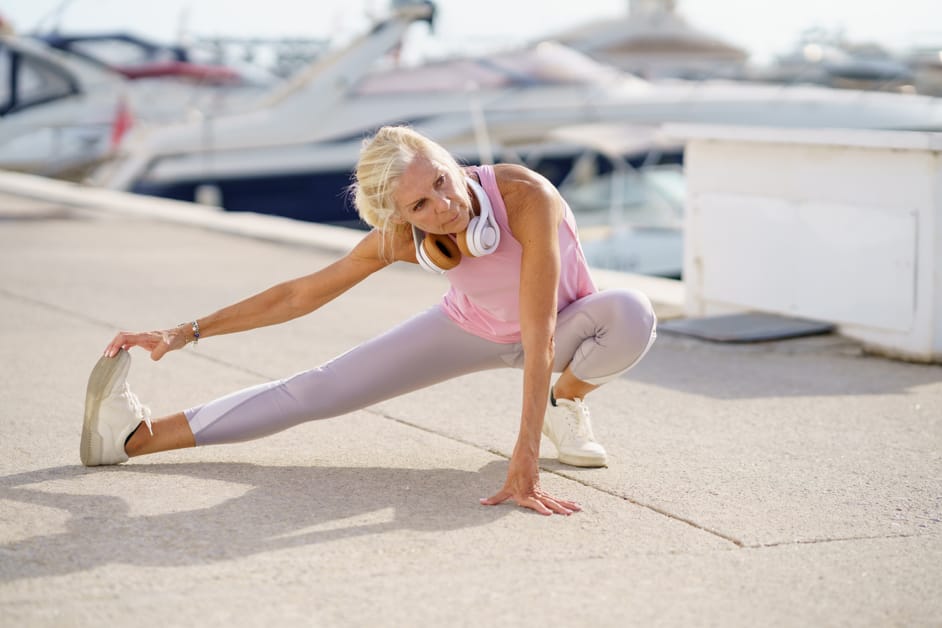Introduction
Dynamic stretching is not like static stretching. It is exercise to get the body ready for activities. It increases range of motion and wakes up muscles for a task. For runners, it bridges from warming up to sprinting.
Dynamic stretching includes force, rotational speed, and flexibility. When runners do this before a run, it lowers injury risk and prepares the body for running.
For runners with knee pain, dynamic stretching is crucial. It is part of warm-up and strengthens the joint over time. This article will look at stretches to reduce knee pain and help athletes with knee issues:
Benefits of Dynamic Stretching
Dynamic stretching is a great way to help runners with knee pain. It increases range of motion and flexibility, and also prepares the body for exercise. It can help reduce tightness in the muscles around the knee and hip joints.
To do dynamic stretching properly, use slow, controlled movements. Don’t overstretch or bounce. Focus on each joint in the lower body.
Examples of dynamic stretching include:
- Walking lunges with trunk twists
- Single leg deadlift with an overhead reach
- Lateral runs with arm swings
- Skater squats with arm circles
- Sumo squats combined with partial swings and side steps on incline benches
Aim for 10-15 reps, depending on your ability. This will warm up your joints before running.
Warm-up
Dynamic stretching can be beneficial for runners who have knee pain. These exercises wake up your body and muscles, getting them ready for running. Here are a few simple dynamic exercises for warming up prior to a run:
- High Knees
- Butt Kicks
- Lunges
- Carioca
- Skips
- Side Shuffles
Light Cardio
Jogging or walking is an important part of a dynamic stretching routine for runners with knee pain. This light warm-up prepares the body for intense movement and increases flexibility, reducing the risk of injury.
Start at a slow pace and gradually increase speed in 10-15 minutes. Focus on using proper form to avoid straining muscles. Maintain good posture with the shoulders over the hips to prevent imbalances in structure. Don’t forget to stay hydrated for maximum results!
- Start at a slow pace and gradually increase speed in 10-15 minutes.
- Focus on using proper form to avoid straining muscles.
- Maintain good posture with the shoulders over the hips to prevent imbalances in structure.
- Don’t forget to stay hydrated for maximum results!
Walking Lunges
Walking lunges are essential for dynamic warm-ups. They can also protect your knees if you’re a runner. It strengthens the muscles in your legs and buttocks, helping them cope with running.
To do it:
- Stand, feet hip-distance apart.
- Step forward with one foot and bend both knees. Your back knee should hover just off the ground, and your front knee should make a 90 degree angle. Make sure your hips stay squared towards the front.
- Push off from your front foot’s heel to come back.
- Repeat with the other leg for 4-6 reps. As you get stronger, increase reps and add weight with small dumbbells.
Glute Activation
Before you start your dynamic stretching exercise, take some time to build muscle strength in the muscles that help with running with knee pain. Glute activation exercises help strengthen gluteal muscles when running for training, running for fitness, or prepping for a race.
Warm-up exercises to do before a dynamic stretching routine:
- Hip Bridge: Lie on your back. Bend your knees and put your feet flat on the floor. Push your heels down and activate your glutes. Lift your hips off the floor until you make a line from shoulders to knees. Hold for 3-5 seconds and then lower your hips. Do 8-10 reps.
- Clamshells: Lie on one side. Shoulder and hip should be facing up. Bend your legs at hip and knee joints to 90 degrees. Keep feet together. Draw your naval to your spine and raise your top knee away from the bottom as far as possible. Put it back parallel and repeat 10 times per leg.
- Fire Hydrant Circles: Start in a kneeling position. Lift one leg off the floor parallel to the ground. Make slow circles (both ways) for 15 times. Switch legs and repeat 10 times each leg.
Lower Body
Running is a good way to be physically fit. Yet, if done wrongly, it can cause knee pain. A dynamic stretching routine is great for warming up and decreasing the danger of harm. We will concentrate on lower body dynamic stretching that helps runners with knee pain in this section.
Glute Bridges
Lie on your back. Knees bent, feet flat on the ground. Push through your heels. Lift hips up into a bridge position. Contract your glutes. Do an isometric hold for up to 10 seconds. To make it dynamic, add hip circles.
- Rotate hips to one side. Slowly release back to center. Do this 10 times in each direction.
- Do 2-3 sets of glute bridges. When done, slowly lower down. Reset. Repeat the circuit.
Fire Hydrants
Fire Hydrants: a dynamic stretching exercise to target your outer hip muscles. Great for warming up your legs and reducing the chances of running-related injuries.
- Get on all fours on a mat. Hands slightly wider than shoulder width apart, shoulders directly over hands. Lift one leg to the side, keep knee bent and foot in tabletop position.
- Rotate the leg outward. Knee pushes out – feel a gentle stretch along the outside of thigh. Return to tabletop position. Move into internal rotation. Foot closer towards you, inside of thigh stretched.
- To increase intensity, use a resistance band. Loop it around both legs for added tension as you rotate back and forth. Do 10 reps per side. One set before switching legs or moving onto another exercise.
Incorporate Fire Hydrants into your dynamic stretching routine. Improve strength, flexibility and range of motion during running.
Calf Raises
Calf raises are great for runners with knee pain. They help strengthen and stretch the calves, improve overall leg strength and flexibility, and reduce the effect of imbalances in thigh muscles. This can also prevent injuries.
To get it right, stand with feet shoulder-width apart and arms relaxed. Shift your bodyweight onto the balls of your feet and raise your heels off the ground. Pause for one to two seconds at the top. Do this 10-12 times. As you progress, aim for 3 sets of 15 reps per side per session.
But be aware: if you feel any pain while doing this exercise, talk to your physical therapist before continuing.
Lateral Lunges
Lateral lunges are great for loosening calves, hamstrings, and hips. Plus, you target the lateral muscles in your legs. This stretches preps the lower body for running and reduces pain in the hips.
- Stand with feet hip-width apart.
- Take a big step to one side. Lower your hip. Bend the opposite knee and point your toes forward. Keep shoulders even. Reach both arms out across from one side to the other. You should feel a stretch on the outer thigh and hip of the bent leg. Hold for 10 seconds. Slowly get up and step back into home position.
- Do this on both sides 10 times. Move on to the next exercise.
Squats
Squats are a great lower-body exercise. They challenge your thigh, glute, and core muscles. Doing them regularly can help build strong muscles in the front and back of your legs. You’ll also get better balance, stability, flexibility, and mobility. Squats are great for all fitness levels.
There are different types like bodyweight squats, goblet squats, front squats, back squats, pistol squats, single leg variations, and squat jumps. Start with an easier variation if you’re new. Then progress to more challenging ones.
When you squat, start from the bottom. This lowers your risk of injury. Also, keep your chest up and your core strong. That’ll help you stay stable during every rep.
Upper Body
Runners with knee pain should do upper body dynamic stretching. It helps to increase range of motion, flexibility, and overall balance. This is essential for healthy running.
Below are some upper body dynamic stretches for runners with knee pain. Before starting, make sure to warm up!
Arm Circles
Arm circles are great for warming up the upper body. They can be done at the start of a workout and to reduce tension.
- Stand with feet shoulder-width apart, feet forward.
- Lift arms to shoulder level.
- Move arms in circles like a windmill. Do 10 circles in each direction – clockwise and counterclockwise.
- Palms should face down.
- Notice tightness or tension in your upper back and shoulders. Relax when doing the circles.
- To finish, bring arms straight out to either side and slowly drop them down. Complete one more rotation before releasing.
Shoulder Rolls
Shoulder rolls are a great way to ease tension and improve shoulder mobility. To get the best out of it:
- Stand with feet hip-width apart, slightly bent knees and arms by your sides.
- Rotate your shoulders in little circles forwards, tightening your abs as you draw your shoulder blades together.
- Do bigger circles without straining or hurting your shoulders.
- Keep arms by your sides and do 10 rotations in each direction (20 reps total).
- Breathe in and out with each rotation.
- You can do this exercise while seated if you don’t have space to stand.
Arm Swings
Arm swings are a dynamic warm-up to help with blood flow and motion in your arms. When stretching, keep the tempo consistent. Move slowly and smoothly.
- Stand with feet hip-width apart. Look forward and pull stomach in. Engage core muscles. Let shoulder blades relax and reach arms out to sides at shoulder flexion.
- Move arms outward from front to back across body until arms are above head with palms facing ceiling. Reverse movement until arms come back to sides.
- Do 10-12 reps with controlled tempo. Don’t hold breath. Keep breathing steady.
Core
Running with knee pain? Core strength is essential! Dynamic stretches before and after your run can help. These stretches reduce stress on the knees. Here are some dynamic stretches for runners with knee pain. Strengthen your core with them!
Plank
Plank is a core dynamic stretch to strengthen your torso core muscles, like the rectus abdominis, transverse abdominis, and obliques. Different variations, like forearm plank and side plank, can be done. This exercise helps your running form by engaging core muscles with each step. Good form prevents knee discomfort, by keeping proprioception in the knee joint and pelvis.
During the plank, keep your hips level to neutral. No arching in your lower back or dipping one hip lower than the other. Hold each position for 10-15 seconds, and repeat 2-3 times, depending on your level of discomfort.
Bird Dog
Bird dog exercises can help the core and balance. This type of exercise uses all major muscle groups, like quads, glutes and abdomen. Plus, it activates smaller stabilizing muscles in the hips, pelvis and spine.
To do a bird dog exercise:
- Start on all fours. Place hands below shoulders and knees below hips. Pull abs inward towards spine.
- Exhale and extend one leg behind you. Keep it straight and lift off floor. Inhale and reach out with opposite arm straight in front. Keep both arms and legs extended as far as possible without dropping. Hold for 3-5 seconds.
- Then, bring them back under without letting any part touch the floor. Do 10 repetitions per side. Aim for 4 sets per side.
To make it harder, move faster or pulse. This targets transverse abdominus and can protect against injury when performing higher intensity exercises.
Bird dog exercises strengthen core and whole body. They also help with other resistance movements or high intensity activities like running, jumping or yoga/pilates.
Side Plank
The side plank is awesome for targeting and strengthening core muscles. It works the gluteus medius, which helps stabilize your hip and stop it from deviating during running. It can help people with knee pain. Plus, it strengthens the hip abductors to protect against injuries.
To do the side plank:
- Start in a prone position on your side. Put your elbow directly under your shoulder and have your body in one straight line. Squeeze/activate your muscles. Then, lift up onto the arm while keeping tension in the body.
- Point your toes forward, with feet slightly apart. Hold that position for 10-15 seconds (depending on strength and flexibility).
- Relax back down to the starting position.
- Do 8-10 reps of the exercise for core activation and stability.
- Remember to keep breathing when doing the side plank!
Cool-down
A cool-down is necessary after running. Dynamic stretches can help runners who have knee pain. Static stretches put too much strain on the knee. Dynamic stretches involve moving through a range of motion.
Let’s look into the types of dynamic stretches to use for your cool-down:
Foam Rolling
Foam rolling is a must for runners after their workout. It helps undo adhesions in the muscles for improved movement and less pain for your next run.
Focus on one to two minutes for each major muscle group. Do one side first, then switch to the other.
- Put the foam roller onto the tight muscle with moderate pressure.
- Roll back and forth for 30 to 60 seconds.
- As you get used to it, roll slower and spend more time on the pressure points.
- Don’t be too intense, or it could hurt or irritate the muscles.
Static Stretches
Dynamic stretching is a great way to warm up for any workout, including running. Then static stretching is ideal for the cool-down. This targets certain muscles and joints in the body. Focus on parts that get worked during running, like the hamstrings, quadriceps, hips and calves. Hold each stretch for 20-30 seconds and do it 2-3 times. Don’t jolt while in the stretch.
Static stretches:
- Hamstring Stretch – Lie on your back with one leg straight in the air, toes pointing towards the ceiling. Reach up and hold the leg behind the thigh. Pull it gently towards you until you feel a light stretch. Hold for 10 seconds, then switch legs.
- Calf Stretch – Stand close to a wall. Put one foot out behind you and lean forward until you feel a stretch. Hold for 10 seconds, then push off with the back foot. Do this after a run of more than 30 minutes. It will help with flexibility, reduce injury risks and improve strength in the calf area.
Conclusion
Dynamic stretching is a great way to get ready for running and lowers the risk of injury. Before beginning a run, do a warm-up. This will help runners with knee pain to do dynamic movements correctly. Remember to do these stretches with someone else, it will help them be more effective and also make sure you have good form.
Dynamic stretching is only part of a running program. Also use other methods to recover, like foam rolling and mobility exercises after a run. With these, runners with knee pain can get the most out of their runs and reduce the chance of getting injured.
Frequently Asked Questions
Q1: What is dynamic stretching?
A1: Dynamic stretching is a form of stretching that involves moving the body and limbs through a full range of motion. It is often used as a warm-up before exercise.
Q2: How often should I do a dynamic stretching routine for runners with knee pain?
A2: It is recommended to perform a dynamic stretching routine for runners with knee pain at least three times a week.
Q3: What type of dynamic stretching exercises are good for runners with knee pain?
A3: Good dynamic stretching exercises for runners with knee pain include leg swings, high knee skips, and walking lunges.





